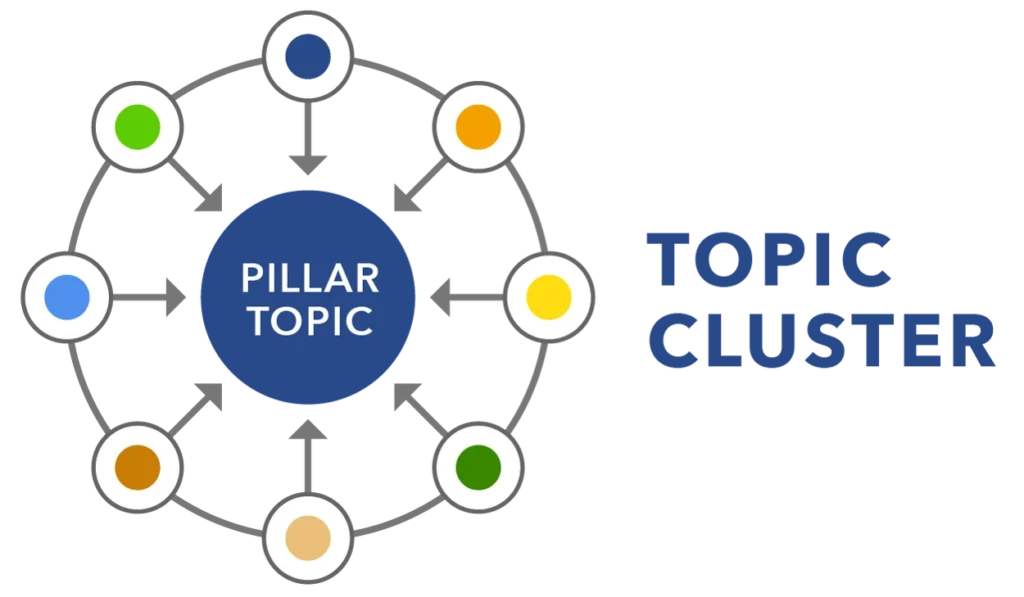Topic Clusters for digital marketers and website owners, staying ahead of the curve in the always changing world of SEO is essential. The idea of subject clusters is one tactic that has become a potent tool for enhancing user experience and search engine rankings. This comprehensive guide will go into the definition of subject clusters, their operation, and the ways in which they can greatly improve your SEO efforts.
Understanding Topic Clusters
What Are Topic Clusters?
Topic clusters are a strategic approach to organizing your content around central themes or topics. This method revolves around creating a “pillar” page that covers a broad topic and multiple “cluster” pages that dive deeper into specific subtopics related to the pillar. The pillar page serves as the main hub of content, linking to and from the cluster pages, which in turn link back to the pillar page. This interconnected structure helps search engines understand the relationship between different pieces of content and improves your site’s overall SEO performance.

How Topic Clusters Work
- Pillar Page: This is a comprehensive, authoritative page on a broad topic. It should cover the topic in depth and serve as a central hub for related content. The pillar page provides a high-level overview and links out to more detailed cluster pages.
- Cluster Pages: These pages focus on specific aspects or subtopics related to the pillar page. They offer in-depth information on these subtopics and link back to the pillar page as well as to other related cluster pages. This structure creates a network of related content that enhances the overall relevance and authority of the site.
- Internal Linking: The cornerstone of topic clusters is the internal linking strategy. The pillar page links to all cluster pages, and each cluster page links back to the pillar and to other cluster pages. This interconnectedness helps distribute page authority and improves the site’s overall SEO.
Benefits of Using Topic Clusters
1. Improved SEO Rankings
One of the primary advantages of topic clusters is their ability to boost SEO rankings. By organizing content around a central theme, you create a clear content hierarchy that search engines can easily understand. This structure helps search engines recognize the relevance and authority of your content, leading to higher rankings for both the pillar and cluster pages.
2. Enhanced User Experience
Topic clusters provide a user-friendly way to navigate content. Visitors can start with the pillar page for a broad overview and then explore specific cluster pages for more detailed information. This organized structure makes it easier for users to find relevant content, increasing engagement and reducing bounce rates.
3. Increased Content Authority
By focusing on a central topic and creating multiple related pages, you establish your site as an authority on that subject. The comprehensive nature of the content and the interconnected structure demonstrate expertise and relevance, which can improve your site’s credibility in the eyes of both search engines and users.
4. Better Content Organization
Topic clusters help streamline content creation and organization. Instead of creating isolated articles, you develop content around central themes, ensuring that all related topics are covered comprehensively. This approach helps maintain a consistent content strategy and makes it easier to identify gaps in your content.
5. Enhanced Internal Linking
The internal linking strategy within topic clusters helps distribute page authority across your site. By linking cluster pages to the pillar page and vice versa, you create a network of related content that enhances the overall SEO value of your site. This internal linking also helps search engines crawl and index your pages more effectively.
Implementing Topic Clusters: A Step-by-Step Guide
1. Identify Your Core Topics
Start by identifying the broad topics that are most relevant to your business or industry. These topics should align with your audience’s interests and search intent. For example, if you run a digital marketing agency, core topics might include SEO, content marketing, and social media strategies.
2. Create Pillar Pages
Develop comprehensive pillar pages for each core topic. These pages should provide an in-depth overview of the topic and serve as the central hub for related content. Ensure that your pillar pages are well-researched, informative, and optimized for relevant keywords.
3. Develop Cluster Content
Create cluster pages that focus on specific subtopics related to each pillar page. These pages should offer detailed information on the subtopics and link back to the corresponding pillar page. Ensure that your cluster content is relevant, engaging, and optimized for related keywords.
4. Implement Internal Linking
Establish a robust internal linking strategy by linking pillar pages to cluster pages and vice versa. This internal linking structure helps distribute page authority and improves the overall SEO of your site. Use descriptive anchor text for your internal links to enhance relevance and user experience.
5. Monitor and Optimize
Regularly monitor the performance of your topic clusters using analytics tools. Track key metrics such as traffic, rankings, and user engagement to assess the effectiveness of your strategy. Based on the data, make adjustments to optimize your content and improve your SEO results.
6. Update and Expand
Continuously update and expand your topic clusters to keep your content fresh and relevant. Add new cluster pages as needed and update existing content to reflect the latest information and trends. Regularly refreshing your topic clusters helps maintain your site’s authority and relevance.

Best Practices for Topic Clusters
1. Focus on User Intent
When creating content for topic clusters, prioritize user intent. Understand what your audience is searching for and tailor your content to address their needs and questions. This user-centric approach ensures that your content remains valuable and relevant.
2. Use Keyword Research
Conduct thorough keyword research to identify relevant keywords for both pillar and cluster pages. Incorporate these keywords strategically into your content to improve search engine visibility and attract organic traffic.
3. Maintain Quality Content
Ensure that all content within your topic clusters is of high quality. Provide valuable, well-researched information that addresses user needs and adds to the overall authority of your site.
4. Optimize for SEO
Optimize both pillar and cluster pages for on-page SEO factors such as meta tags, headings, and image alt text. Ensure that your content is easily accessible to search engines and users.
5. Promote Your Content
Promote your topic clusters through social media, email marketing, and other channels to drive traffic and increase visibility. Encourage external backlinks to further enhance the authority of your content.

Conclusion
Topic clusters offer a powerful strategy for improving SEO, enhancing user experience, and establishing content authority. By organizing content around central themes and creating a network of related pages, you can boost your site’s search engine rankings, engage your audience, and streamline your content strategy. Implementing topic clusters requires careful planning and ongoing optimization, but the benefits of this approach make it a valuable investment for any digital marketing strategy.
Embrace the topic cluster strategy to take your SEO efforts to the next level and create a well-organized, authoritative content hub that resonates with both search engines and users. GMI



